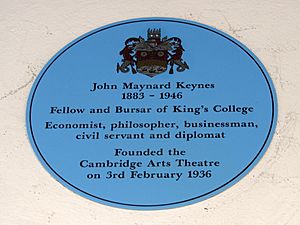Keynesian economics facts for kids
Keynesian economics (also known as Keynesianism) is a set of ideas about how an economy works. These ideas come from a famous economist named John Maynard Keynes. He wrote about them in his important book, The General Theory of Employment, Interest and Money, which came out in 1936.
Keynes believed that capitalism was a good way to organize an economy. In a capitalist system, people earn money from their jobs. Businesses hire people and pay them. Then, people can spend their money on things they need or want. Other people work to make those things.
Sometimes, the capitalist system can have problems. People might lose their jobs, and businesses might close down. When this happens, people don't have money to spend. Keynes thought that the government should step in and help when the economy is struggling.
This idea is called "demand-side policy." It means that if people are working and spending money, the economy is healthy. If people aren't working, the economy gets sick.
Keynes noticed that when the economy is bad, people tend to save their money instead of spending it. This means less buying and selling, which slows down the economy even more.
He suggested that when many people are out of work, the government should spend more money. The government could borrow money and create jobs. For example, it could pay people to build roads or schools. When people have jobs, they can start spending money again. This helps businesses, which then hire more people, and the economy starts to get better.
Different Views on Keynesian Ideas
Not everyone agrees with Keynes's ideas. Some people, like conservatives, libertarians, and those who follow Austrian economics, believe that government spending doesn't really help capitalism. They argue that when the government borrows money, it takes money away from businesses that could use it to grow. They think the economy can fix itself without the government's help.
In the late 1970s, Keynesian economics became less popular. This was because both inflation (when prices go up a lot) and unemployment (when many people don't have jobs) were high at the same time. Many people thought Keynesian theory said this couldn't happen.
However, when a big recession (a time when the economy shrinks) happened in 2007, Keynesian economics became popular again. Leaders around the world, including Barack Obama, used Keynes's ideas. They created "stimulus packages," which meant their governments spent a lot of money to create jobs and boost the economy.
Keynes's Main Ideas
Keynes had several key ideas about how the economy works:
- What drives jobs: He believed that the number of jobs and how much is produced depends on how much people buy and sell (the market for goods), not just how many people want to work.
- Unemployment can happen: It's possible for people to be unemployed even if they really want to work and are looking for jobs.
- Saving vs. Investing: If people save more money, it doesn't always mean that businesses will invest more. People can choose to save their money or invest it in businesses.
- Money-based economy: An economy that uses money is different from one where people just trade goods directly (like bartering). Money changes how people make decisions.
- Money and jobs: The idea that more money in the economy always leads to higher prices (the quantity theory of money) is only true when almost everyone has a job. If many people are unemployed, adding more money might just create more jobs instead of just raising prices.
Images for kids
See also
 In Spanish: Keynesianismo para niños
In Spanish: Keynesianismo para niños



